[ad_1]
As a consequence of their prominence, well-developed again muscle groups have been described as wings. Need wing-like again muscle groups? On the quick listing of issues that allegedly “provide you with wings” are power drinks, good deeds, and higher physique vertical pulling.
After consuming power drinks all through my youthful years, I can dispatch the primary declare. Alertness and insomnia? Sure. Again muscle groups? No. As for good deeds, it is a health article so it shall be stored secular. That leaves vertical pulling — pull-ups and pulldowns.
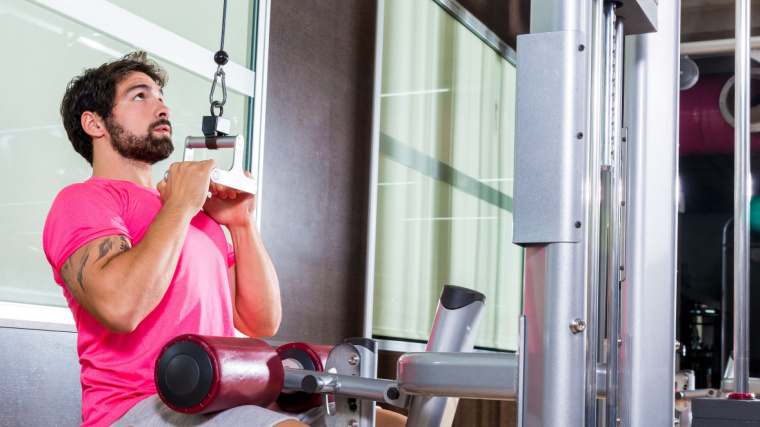
Though pull-ups might be modified for nearly everyone, nothing beats the adjustability and comfort of cable-stack pulldowns. However the conventional overhand grip isn’t for everybody, particularly these with shoulder points. (1)(2)(3)
The neutral-grip lat pulldown is a shoulder- and elbow-friendly various to straightforward lat pulldowns. Learn the way to carry out, program, and modify this massive again builder.
Impartial-Grip Lat Pulldown
Impartial-Grip Lat Pulldown Approach Breakdown
Dr. Merrick Lincoln demonstrates how you can do a neutral-grip pulldown and talks you thru a whole repetition. Test to see what kind appears to be like like earlier than studying on for the main points.
The best way to Do the Impartial-Grip Lat Pulldown Step By Step
Versus utilizing a straight or cambered “lat bar,” the neutral-grip pulldown requires use of a bar with grips operating perpendicular to the size of the bar. This lets you maintain your forearms in a “impartial” rotation, along with your palms dealing with one another, midway between full supination (palms dealing with towards you) and full pronation (palms dealing with away from you).
Step 1 — Set up Factors of Contact
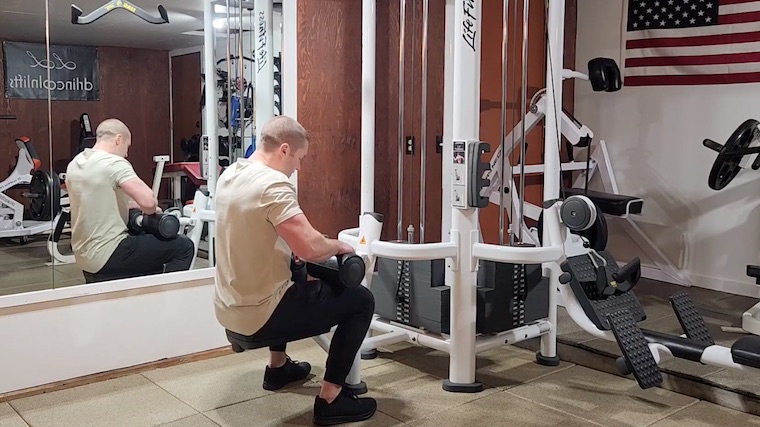
Face a cable machine along with your glutes on the seat, each toes flat on the ground, and your higher legs underneath the thigh pad. If mandatory, modify the peak of the thigh pad or seat for safe match.
Kind Tip: When setting the peak of the thigh pad or seat, guarantee your toes are flat on the ground along with your heels barely behind your knees. This allows you to simply slide your toes again to face when it’s time to retrieve or return the pulldown bar.
Step 2 — Seize the Bar and Set Your Trunk Angle
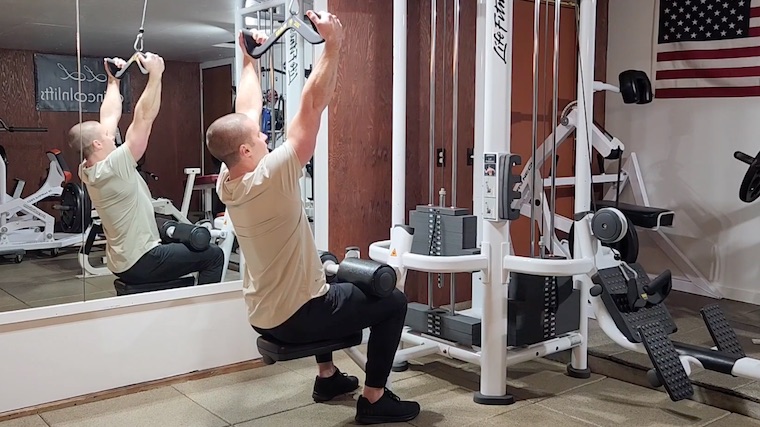
Seize the handles with a shoulder-width, or barely narrower, place. If the bar has conventional cylinder-shaped grips, use a totally closed grip along with your fingers and thumb wrapped across the bar. If the bar has extra trendy paddle-style or angled grips, make sure the palms of your palms make most contact with the paddles. With this deal with, the knuckles of your fingers must be flexed excessive of the deal with.
As soon as your grip is safe, raise your chest, lean again barely (e.g. 10 to 30-degrees from vertical), and brace your core. Preserve this trunk place all through the train. Within the stretched place, your elbows must be locked utterly straight.
Kind Tip: In case you have vary of movement limitations within the overhead place, you might profit from leaning again barely additional (e.g. roughly 30-degrees from vertical). This modifications the pulling angle and reduces stress in your shoulder joints.
Step 3 — Pull All the way down to Peak Contraction
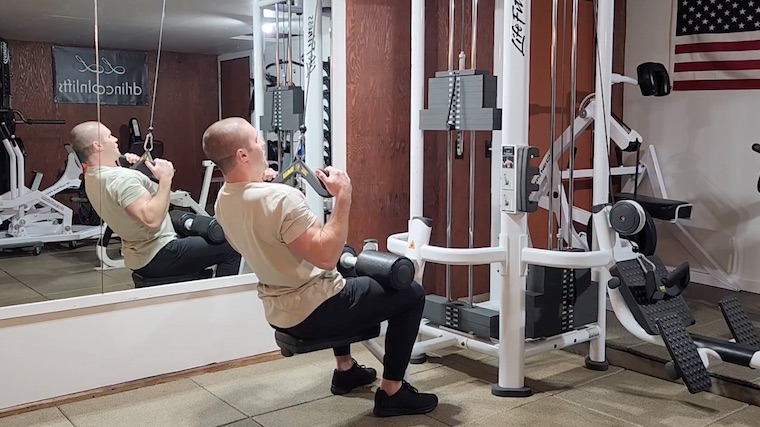
Provoke the motion by drawing your shoulder blades collectively and down, and “pull your shoulder blades into your again pockets.”
Instantly after starting to maneuver your shoulder blades, start pulling your elbows towards the perimeters of your ribcage. Peak contraction is achieved when your shoulder blades are squeezed collectively and down, and your higher arms are pinned to your sides.
Kind Tip: Don’t fear about getting the bar to your chest, under your chin, or to another arbitrary place. Concentrate on reaching a robust contraction in your again muscle groups while you attain the underside place.
Step 4 — Return and Search Stretch
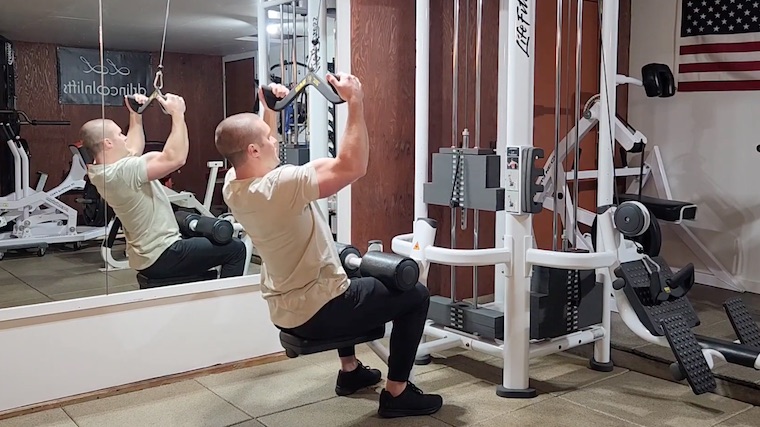
Decrease the load and permit your arms to be drawn upward, slowly letting your elbows lengthen. On the identical time, permit your shoulder blades to be elevated. The upward motion section ends when elbows are utterly straight and a robust sensation of stretch is felt throughout the surface of your armpits — that feeling is your lat muscle groups being correctly stretched.
Kind Tip: As your arms are drawn overhead and your latissimus dorsi are stretched, your low again would possibly are inclined to arch. Keep away from this by maintaining your belly muscle groups engaged to keep up a impartial torso.
Impartial-Grip Lat Pulldown Errors to Keep away from
Frequent errors within the neutral-grip pulldown happen when vary of movement goes unchecked, when compensations are permitted, and when your arms “out-muscle” your again.
Extreme Vary of Movement
The uninitiated typically assume the pulldown will not be full till the bar touches their chest. That is inaccurate. Hyperextension of your shoulder locations further stress on the entrance of the shoulder. (4)(5) This isn’t usually good for people with anterior shoulder instability, a prevalent situation amongst lifters. (4) Additionally, think about the physics of hyperextending the shoulders on the backside of the pulldown — Demand on the shoulder muscle groups truly decreases because of a shortened resistance lever.
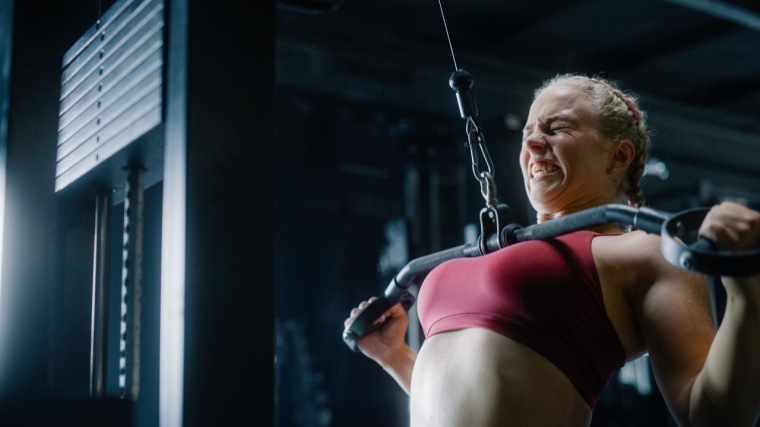
Nonetheless satisfied touching the bar to your chest is “mandatory?” Watch a handful of oldsters with barndoor backs carry out neutral-grip pulldowns. They don’t contact the bar to their chest — Albeit, they doubtless couldn’t in the event that they wished to as a result of measurement of their latissimus dorsi and teres main muscle groups.
Keep away from it: rule of thumb for pulldown vary of movement is to pull down and again till your triceps squeeze towards your lats. Obtain a robust contraction, then start the upward motion.
Slouching Into the Repetition
The sticking level, or most difficult a part of the repetition, happens close to the underside of the downward pulling section. Novice lifters typically work by way of this portion of the raise by rounding their shoulders ahead and flexing their mid-back. This provides the looks of “crunching” or slouching on the backside of the repetition.
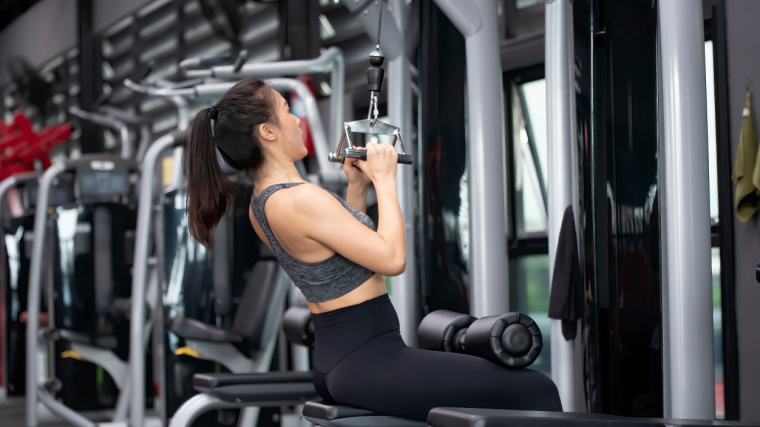
Keep away from it: As you pull, maintain focus in your again muscle groups by reminding your self to create area between the entrance of your shoulder and the cable pulley.
“Curling” the Weight Down
Whereas it’s true the neutral-grip pulldown generally is a nice biceps-builder, it’s not meant to be an arms-focused train. Lifters who provoke the pulldown with elbow flexion and “muscle” the bar down with their elbow flexors are lacking out on again good points.
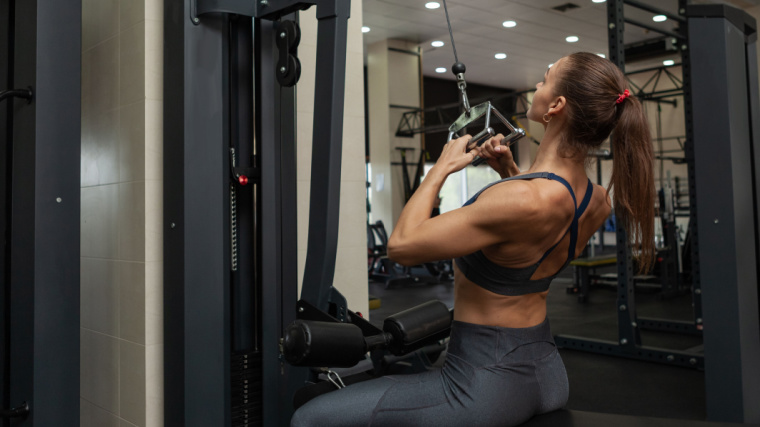
Keep away from it: Carried out correctly, upper body vertical pulling exercises (i.e. pull-ups and pulldowns) are initiated by again muscle groups, particularly your decrease trapezius and latissimus dorsi. (8) These muscle groups ought to activate a split-second earlier than your biceps. Guarantee this sequence by downwardly rotating and miserable your shoulder blades to start every rep or “pull your shoulder blades into your again pockets.”
The best way to Progress the Impartial-Grip Lat Pulldown
To study the neutral-grip pulldown, begin with mild weight. Over time, progress the train by including weight and/or repetitions. Incorporating strategic pauses might also be helpful for dialing-in correct kind and building strength.
Begin Mild, Add Weight and Reps
As soon as correct kind is dialed in, progress the pulldown by including weight. The quantity of weight you add must be associated to your major coaching purpose. A weight that permits 4 to 6 good repetitions is an efficient goal while you’re prioritizing energy. A variety of weights might be efficient for hypertrophy, so decide a weight that permits a repetition goal you like (e.g. eight to 12 repetitions, 12 to 16 repetitions, or 16 to twenty repetitions).
When you’ve established your working weight, you will want so as to add weight or repetitions over time to make sure you are progressively overloading your muscle groups. A easy technique is so as to add repetitions, then add weight when you’ve exceeded the highest finish of your goal repetition vary. For instance, if you happen to/re aiming for eight to 12 repetitions per set, begin by figuring out a weight that lets you carry out roughly eight repetitions.
In every week or two, you’ll doubtless be hitting 9 or 10 repetitions with the identical weight. Finally, you’ll attain 13 repetitions, which is the sign so as to add weight. Be aware: In case you have a bit extra training experience, good points typically come extra slowly and also you would possibly think about the occasional deload to make sure ongoing progress.
Add “Iso-Holds”
Close to the underside place of a pulldown, when your elbows are bent and simply in entrance of your chest, the resistance on the shoulder is amplified by the size of the humerus (higher arm bone). That is the sticking level, or portion of the train the place muscular failure or kind breakdown is almost definitely to happen. It’s additionally the right place for including an isometric maintain or “iso-holds.” That is an intensification method used to extend time underneath pressure and enhance energy at focused positions.
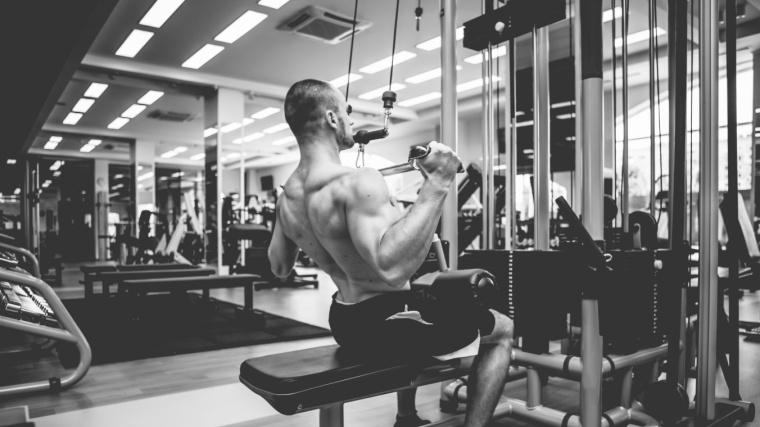
So as to add an iso-hold, merely cease on the most difficult portion of the pulldown. Maintain for 4 to 6 seconds, after which full the repetition. Iso-holds might be carried out on the ultimate repetition to maximise set efficiency or integrated on each repetition. Take into account, you’ll doubtless have to decrease the load or repetition goal if you happen to intend to make use of iso-holds on each rep.
Advantages of the Impartial-Grip Lat Pulldown
Certain, there are a variety of again workout routines you may do on the health club, so why concentrate on this pulldown variations? With good effort and first rate programming, lifters can construct respectable measurement and energy with the neutral-grip pulldown as a result of setup, vary of movement, and user-friendliness.
Works Again Muscle tissue By way of a Full Vary of Movement
Throughout pulldowns, shoulders attain the overhead place on the prime of each repetition. This exposes the goal muscle groups to substantial stretch and cargo. This mechanical pressure is a key driver of muscle progress. (6) In contrast to rows, for instance, which solely prepare the muscle groups by way of a comparatively partial vary of movement, pulldowns attain most or near-maximum stretch on the goal muscle groups.
Full vary of movement coaching could lead to extra muscle acquire over time. (7) As a bonus, full vary of movement coaching is probably going to enhance flexibility as successfully, or much more successfully, than stretching. (9)
An Different for Banged Up Shoulders and Elbows
Though traumatic accidents amongst resistance trainees are considerably unusual, a big share of lifters complain of painful shoulders and elbows. (4)(10) The lion’s share of those points can typically be attributed to overuse or coaching errors.
Forearm place throughout train impacts the stress and pressure skilled by joint buildings, connective tissues, and muscle groups across the elbow. (11) Buildings across the shoulders expertise totally different patterns of stress primarily based in your arm path. For instance, the “excessive 5” place of abduction and exterior rotation handed by way of throughout conventional lat pulldowns is related to elevated stress the entrance of the shoulder. (4)(1)(3) Quickly avoiding this place could also be indicated within the presence of sure shoulder accidents.
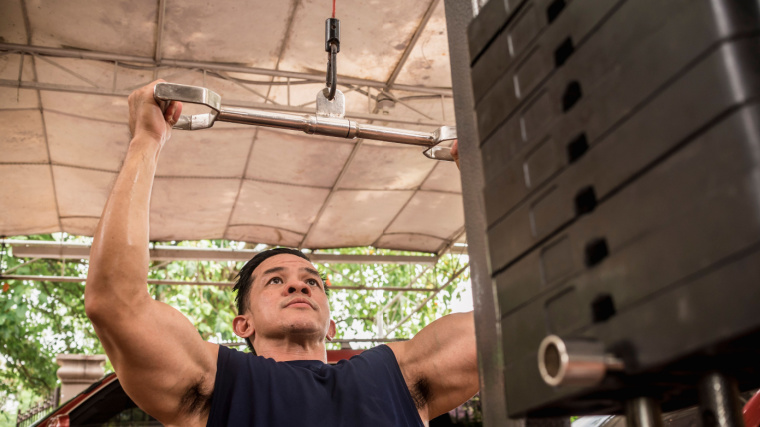
It might be prudent for lifters to include neutral-grip variations to scale back the danger of overuse. Periodically switching out pull-ups or conventional lat pulldowns for a barely totally different vertical pulling workout routines, corresponding to neutral-grip pulldowns could assist to keep off overuse-type accidents.
Lifters already contending with overuse accidents associated to higher physique pulling could want to experiment with variations such because the neutral-grip pullover to find out whether or not it’s higher tolerated than earlier workout routines.
Permits Simple Use of Superior Coaching Methods
Superior coaching strategies can embody strategies used to take units previous failure (e.g. forced reps, drop units, rest-pause), delay failure (e.g. cluster units), or improve time underneath pressure by imposing a tempo (e.g. reducing the load very slowly with six-second eccentrics). (12) The neutral-grip pulldown is usually carried out on a secure and secure machine that permits for environment friendly use of those strategies.
The pulldown machine permits fast manipulation of weight — Simply transfer the pin or slide plates on or off. This permits for environment friendly efficiency of drop units. The machine can also be self-contained and “self-spotting.” If muscular failure is reached, there may be little or no likelihood of getting pinned underneath weight. Simply rise up and management the pulldown bar again to the highest place.
Equally, if the lifter needs to take relaxation inside a given set (i.e. cluster set coaching), the machine permits for fast stops and begins. Lastly, the seated place on the machine permits for a coaching associate to securely and effectively help the lifter to carry out further reps. Superior coaching strategies are removed from straightforward, however the pulldown setup makes them about as environment friendly as they are often.
Muscle tissue Labored by Impartial-Grip Lat Pulldown
The neutral-grip pulldown hammers muscle groups of the again, shoulders, and arms. (3)(13)(14) The pulldown is a comparatively elementary motion as a result of it recruits numerous higher physique muscle groups and works them by way of a big vary of movement.
Shoulder Extensors — Lats, Higher Again, Deltoids
The neutral-grip pulldown targets the muscle groups that reach the shoulders or draw the arms from in entrance of the physique towards the again of the physique. They primarily embody the latissimus dorsi, teres main, rear deltoids, and the lengthy head (or innermost portion) of the triceps brachii. Apparently, the decrease a part of the pectoralis main (“costal fibers” of the chest) contribute to the pulldown as nicely. (14)
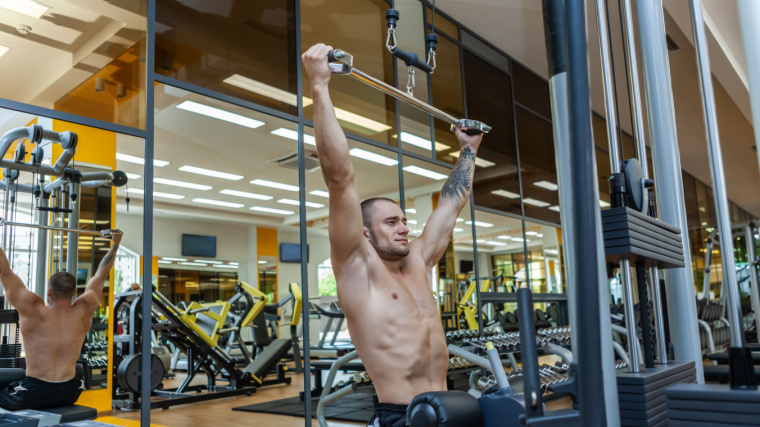
Collectively, the shoulder extensors have the potential to be extremely aesthetic muscle groups. Effectively-developed latissimus dorsi offers the again breadth, whereas teres main and rear deltoid improve shoulder dimensions. And if any hole stays between the arms and higher sweep of the lats, constructing the lengthy head of triceps brachii will seem to fill it in. “Wings” achieved.
Mid-Again
Typically known as “scapular muscle groups,” the muscle groups of the mid-back act in your shoulder blades. No massive again is full with out the visible curiosity and depth of well-developed scapular muscle groups.
Whereas these muscle groups will not be the first goal of the pulldown, they are going to obtain a coaching impact. In the course of the pulldown, the rhomboids, decrease trapezius, and center trapezius rotate the shoulder blades downward, pull them collectively, and draw them towards the small of your again.
Elbow Flexors
Curls aren’t the one solution to construct massive biceps. Drawing resistance towards the physique trains the muscle groups of elbow flexion (bending your arms) — Particularly, your biceps brachii, brachioradialis, and brachialis. Purposeful significance however, these muscle groups give your arms a extra muscular, anaconda-like look.
The best way to Program the Impartial-Grip Lat Pulldown
Impartial-grip pulldowns can match properly into most lifters’ packages in a full body workout, back day, or pulling session. Whether or not your main coaching purpose is energy or muscle acquire, an overarching suggestion is to carry out neutral-grip pulldowns earlier within the exercise to maximise variations.
As a Main Train for Power
The neutral-grip lat pulldown is lengthy range-of-motion, multi-joint train that permits incremental loading. These options make it ultimate to be used as a major train in your “again day” or “pull day” routine. Main workout routines, typically termed “core workout routines” in some circles, are usually positioned earlier within the exercise earlier than any “accent workout routines,” that are usually single-joint workout routines or rehab/prehab work.
This train order is most well-liked, as a result of multi-joint train efficiency tends to endure when carried out after isolation train. (15) Furthermore, workout routines carried out earlier within the exercise are inclined to stimulate larger enchancment in energy. (16)
To prioritize again energy, hit two to 5 units of 4 to 6 repetitions utilizing 85% or larger of your one-repetition most (1RM), ideally early in your exercise. (17)
As Excessive-Quantity Hypertrophy Work
In case your coaching focus is constructing an enormous again, tackle neutral-grip pulldowns towards the start of your exercise. As a consequence of heavy involvement of the biceps brachii and different elbow flexors, it’s best apply to carry out pulldowns earlier than curls or different direct biceps exercises.
Some analysis has proven that as few as three units of barbell curls carried out earlier than pulldowns can lower back-training efficiency by three to 5 repetitions. (13) Misplaced repetitions doesn’t bode nicely for optimum muscle acquire, as hypertrophy is positively associated to train quantity (i.e. complete weekly units x reps). (18) Maximize pulldown quantity by performing this train early within the exercise.
For constructing greater again and biceps, carry out three to 6 units of eight to twenty repetitions utilizing a weight that brings every set inside three or fewer repetitions of failure.
Impartial-Grip Lat Pulldown Variations
In your back-building quest, there are a lot of variations of the neutral-grip pulldown to assist transfer you ahead. Choose essentially the most acceptable variation primarily based on private choice, tools availability, and objectives.
Impartial-Grip Pull-Up
No pulldown machine? Favor pull-ups over pulldowns?— Swap neutral-grip pulldowns for pull-ups. If a number of neutral-grip widths can be found, begin with those closest to shoulder-width or barely narrower.
Regardless of the very fact your body weight offers the resistance, the mechanics of the neutral-grip pul-up are just like the neutral-grip pulldown. Begin from a dead-hang, provoke out of your shoulder blades, and pull your elbows right down to your sides.
V-Bar Lat Pulldown
Utilizing a slender v-bar or “chinning triangle” attachment ends in a tighter arm path and hits your again and arms otherwise. Impartial-grip pulldowns with the v-bar seem to rely extra closely on the biceps brachii than shoulder-width and vast neutral-grip variations. (13) So the v-bar pulldown is a good possibility for these prioritizing sturdy, thick arms.
The v-bar pulldown is carried out very like the neutral-grip pulldown besides the lifter ought to concentrate on squeezing the elbows and forearms collectively all through the train. Elbows ought to graze your ribcage under your pecs as you method the underside place of the train.
Half-Kneeling Single-Arm Lat Pulldown
Single-arm lat pulldowns are great for feeling the stretch and contraction of your latissimus dorsi and different shoulder extensor muscle groups by way of a big arc and lengthy vary of movement. As a result of every arm is labored individually, they’ll additionally assist to deal with any doable side-to-side energy asymmetries.
The half-kneeling single-arm lat pulldown is the following stage of single-arm pulling. The “half-kneeling” place (i.e. one knee down) offers a big, secure footprint for the addition of delicate trunk actions. These trunk actions permit extra stretch on the prime adopted by a stronger peak contraction on the backside of every rep. The previous could improve “stretch-mediated” muscle progress, whereas the squeeze on the backside promotes mind-muscle connection and elevated latissimus dorsi exercise. (6)(19)
Face the cable stack and kneel with the working facet knee down. Permit your shoulder blade to be pulled up for a full stretch by way of your lat. Aspect-bend your trunk barely away out of your working arm. Pull by drawing your shoulder blade and elbow down and in. Obtain peak contraction by aggressively pulling your arm to your ribcage and side-bending barely towards the working facet. Concentrate on feeling your lats “cramp” on the backside of every rep.
Swiss Bar Pullover
The pullover is an exceptional train for the shoulder extensor muscle groups — Latissimus dorsi, posterior deltoid, a part of your pectoralis main, and many others. Though generally completed with a each palms on a single dumbbell, the pullover might also be carried out utilizing a neutral-grip implement corresponding to a Swiss bar, a multi-grip barbell, or triceps bar.
The Swiss bar could allow these with less-than-ideal vary of movement (i.e. restricted forearm pronation or shoulder exterior rotation) to reap the advantages of pullovers – Particularly, heavy loading overhead when the goal muscle groups are at their longest lengths, which can improve progress.(6)(20)(21) Simply be sure you have an attentive spotter because of free weights passing over your head and face in the course of the motion.
FAQs
It’s common to make use of lifting straps throughout pulling workout routines corresponding to deadlifts and barbell rows. Lifting straps could improve the quantity of weight a lifter can deal with, extend the set by minimizing grip fatigue, and spare your grip for subsequent workout routines.
Whereas it’s doable to make use of straps for neutral-grip pulldowns, it’s usually not mandatory. The neutral-grip place tends to stronger than a pronated (overhand) grip, though not as sturdy as supinated (underhand) grip. (22) Furthermore, skilled lifters have exhibitd no useful results of lifting straps on pulldown one-repetition most, repetitions to failure, or complete repetitions throughout three units to failure. (23) That being stated, if you happen to prepare deadlifts during a back workout, there is perhaps advantages to utilizing straps to protect your grip if you’re performing heavier pulls later within the exercise.
In comparison with different pulldown variations, the neutral-grip pulldown could bias sure shoulder muscle groups and even sure elements of the lats.
Whereas some neuromuscular methods could differ because of grip orientation, extra notable variations might be attributed to variations in grip width. The lat pulldown historically makes use of a comparatively vast grip, which ends up in resisted shoulder adduction (i.e. pulling your arms down and into the perimeters of your physique). (24) neutral-grip pulldown usually makes use of a shoulder-width or barely narrower grip. This grip width ends in resisted shoulder extension (i.e. pulling your arms towards the again of your physique).
Probably the most dependable methodology of figuring out a muscle’s motion is to investigate its second arm (how a muscle crosses the joint and the way a lot leverage it has over the joint). For instance, muscle groups crossing behind the shoulder will lengthen the shoulder once they shorten. Shoulder extensors with a bigger second arm lengthen the shoulder extra effectively.
Because the posterior deltoids and teres main have the best second arms for shoulder extension by way of a lot of the pulldown’s vary movement, it may very well be inferred that the neutral-grip pulldown will emphasize these muscle groups. (14)
The latissimus dorsi is a broad, multi-part muscle with fibers originating on the pelvis (“iliac half”), lumbar area (“lumbar half”), and decrease thoracic backbone (“thoracic half”). Sure elements are mechanically higher suited to adduct the shoulder (i.e. iliac- and lumbar elements), whereas the higher portion of latissimus dorsi (i.e. thoracic half) is a robust shoulder extensor. (14)
Placing that every one collectively, from a mechanical standpoint, conventional lat pulldowns could finest goal the iliac and lumbar elements of the latissimus dorsi (“decrease lats”), whereas neutral-grip pulldowns could higher goal the thoracic a part of latissimus dorsi (“higher lats”), teres main, and posterior deltoid.
In the end, extra analysis is required. To cowl your bases for full again improvement, incorporate each pulldown variations into your coaching plan.
First, let’s look at how these rotating handles are sometimes used. The handles are generally held within the pronated (“overhand grip”) place on the prime of the pulldown then progressively twisted into the supinated (“underhand grip”) place on the backside of the repetition.
An alternative choice is to keep up the identical grip and forearm place all through the pulldown. You could possibly maintain the rotating handles in a impartial place (or some other place) all through the repetition; nevertheless, this feature introduces an extra diploma of freedom (learn: “instability”) and will lead to lowered most weight or repetition efficiency.
The rotating methodology feels very pure for some lifters. Anecdotally, twisting the deal with all through the repetition promotes shoulder exterior rotation in the course of the pulldown. This is perhaps helpful for maintaining pressure on major muscle groups like latissimus dorsi and teres main.
Goal analysis on rotating handles is sparse, nevertheless. Some analysis has reported pull-ups carried out with rotating handles elevated latissimus dorsi muscle electromyography (EMG) exercise, albeit to not a stage reaching statistical significance. (8) However interpret these findings with warning. It should be acknowledged that muscle exercise through floor EMG will not be an indicator of the standard of an train and it doesn’t essentially imply rotating handles promote higher lat progress or energy. (25)(26)
In the end, if rotating handles really feel extra pure or extra comfy to you, go forward and use them as an alternative of a inflexible pulldown bar.
Earn Your Wings
The neutral-grip lat pulldown builds a large again and thick arms in addition. When carried out with a shoulder-width or barely narrower grip, it tends to be a joint-friendly train in your lats, higher again, mid-back, and biceps. Altogether, neutral-grip lat pulldowns could also be among the many finest choices for constructing a set of wings when your shoulders produce other plans.
References
- Escalante, G. (2017). Train modification methods to forestall and prepare round shoulder ache. Power & Conditioning Journal, 39(3), 74-86.
- Ribeiro, A. S., Nunes, J. P., & Schoenfeld, B. J. (2020). Number of resistance workout routines for older people: the forgotten variable. Sports activities Drugs, 50, 1051-1057.
- Charges, M., et al. (1998). Higher extremity weight-training modifications for the injured athlete. The American journal of sports activities medication, 26(5), 732-742.
- Kolber, M. J., Corrao, M., & Hanney, W. J. (2013). Traits of anterior shoulder instability and hyperlaxity within the weight-training inhabitants. The Journal of Power & Conditioning Analysis, 27(5), 1333-1339.
- Watson L, et al. (2016). The remedy of multidirectional instability of the shoulder with a rehabilitation program: Half 1. Shoulder & Elbow. 8(4):271-278
- Wackerhage, H., et al. (2019). Stimuli and sensors that provoke skeletal muscle hypertrophy following resistance train. Journal of Utilized Physiology, 126(1):30-43.
- Kassiano, W., et al. (2022). Which ROMs Result in Rome? A Systematic Overview of the Results of Vary of Movement on Muscle Hypertrophy. The Journal of Power & Conditioning Analysis, 10-1519.
- Youdas, J. W., et al. (2010). Floor electromyographic activation patterns and elbow joint movement throughout a pull-up, chin-up, or perfect-pullup™ rotational train. The Journal of Power & Conditioning Analysis, 24(12), 3404-3414.
- Morton, S. Ok., et al. (2011). Resistance coaching vs. static stretching: results on flexibility and energy. The Journal of Power & Conditioning Analysis, 25(12), 3391-3398.
- Siewe, J., et al. (2014). Accidents and overuse syndromes in aggressive and elite bodybuilding. Worldwide Journal of Sports activities Drugs, 35(11), 943-948.
- Bryce, C. D., & Armstrong, A. D. (2008). Anatomy and biomechanics of the elbow. Orthopedic Clinics of North America, 39(2), 141-154.
- Krzysztofik, M., Wilk, M., Wojdała, G., & Gołaś, A. (2019). Maximizing muscle hypertrophy: a scientific overview of superior resistance coaching strategies and strategies. Worldwide journal of environmental analysis and public well being, 16(24), 4897.
- Vilaça-Alves, J., et al. (2014). Results of pre-exhausting the biceps brachii muscle on the efficiency of the entrance lat pull-down train utilizing totally different handgrip positions. Journal of Human Kinetics, 42(1), 157-163.
- Ackland, D. C., Pak, P., Richardson, M., & Pandy, M. G. (2008). Second arms of the muscle groups crossing the anatomical shoulder. Journal of Anatomy, 213(4), 383-390.
- Figueiredo, T., et al. (2016). Affect of Train Order on One and Ten Repetition Most Masses Willpower. Journal of Train Physiology On-line, 19(2).
- Nunes, J. P., et al. (2021). What affect does resistance train order have on muscular energy good points and muscle hypertrophy? A scientific overview and meta-analysis. European Journal of Sport Science, 21(2), 149-157.
- Peterson, M. D., Rhea, M. R., & Alvar, B. A. (2004). Maximizing energy improvement in athletes: a meta-analysis to find out the dose-response relationship. The Journal of Power & Conditioning Analysis, 18(2), 377-382.
- Figueiredo, V. C., de Salles, B. F., & Trajano, G. S. (2018). Quantity for muscle hypertrophy and well being outcomes: the best variable in resistance coaching. Sports activities Drugs, 48, 499-505.
- Snyder, B. J., & Leech, J. R. (2009). Voluntary improve in latissimus dorsi muscle exercise in the course of the lat pull-down following skilled instruction. The Journal of Power & Conditioning Analysis, 23(8), 2204-2209.
- Maeo, S., et al. (2022). Triceps brachii hypertrophy is considerably larger after elbow extension coaching carried out within the overhead versus impartial arm place. European Journal of Sport Science, 1-11.
- Pedrosa, G. F., et al. (2021). Partial vary of movement coaching elicits favorable enhancements in muscular variations when carried out at lengthy muscle lengths. European Journal of Sport Science, 1-11.
- Murugan, S., et al. (2013). Grip energy modifications in relation to totally different physique postures, elbow and forearm positions. Int J Physiother Res, 1(4), 116-121.
- Valério, D. F., etal. (2021). The consequences of lifting straps in most energy, variety of repetitions and muscle activation throughout lat pull-down. Sports activities Biomechanics, 20(7), 858-865.
- Snarr, R., Eckert, R. M., & Abbott, P. (2015). A comparative evaluation and strategy of the Lat Pull-down. Power & Conditioning Journal, 37(5), 21-25.
- Vigotsky, A. D., et al. (2018). Deciphering sign amplitudes in floor electromyography research in sport and rehabilitation sciences. Frontiers in Physiology, 985.
- Vigotsky, A. D., et al. (2017). Larger electromyographic responses don’t indicate larger motor unit recruitment and ‘hypertrophic potential’ can’t be inferred. The Journal of Power & Conditioning Analysis, 31(1), e1-e4.
Featured Picture: MDV Edwards / Shutterstock
[ad_2]

